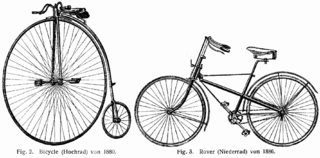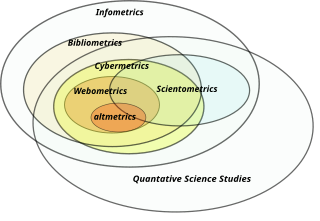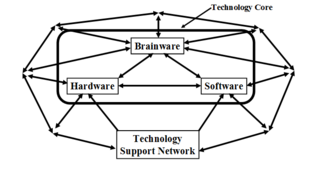
Cyberspace is a concept describing a widespread interconnected digital technology. "The expression dates back from the first decade of the diffusion of the internet. It refers to the online world as a world 'apart', as distinct from everyday reality. In cyberspace people can hide behind fake identities, as in the famous The New Yorker cartoon." The term entered popular culture from science fiction and the arts but is now used by technology strategists, security professionals, governments, military and industry leaders and entrepreneurs to describe the domain of the global technology environment, commonly defined as standing for the global network of interdependent information technology infrastructures, telecommunications networks and computer processing systems. Others consider cyberspace to be just a notional environment in which communication over computer networks occurs. The word became popular in the 1990s when the use of the Internet, networking, and digital communication were all growing dramatically; the term cyberspace was able to represent the many new ideas and phenomena that were emerging.
A hierarchical organization or hierarchical organisation is an organizational structure where every entity in the organization, except one, is subordinate to a single other entity. This arrangement is a form of a hierarchy. In an organization, the hierarchy usually consists of a singular/group of power at the top with subsequent levels of power beneath them. This is the dominant mode of organization among large organizations; most corporations, governments, criminal enterprises, and organized religions are hierarchical organizations with different levels of management, power or authority. For example, the broad, top-level overview of the general organization of the Catholic Church consists of the Pope, then the Cardinals, then the Archbishops, and so on.

In business theory, disruptive innovation is innovation that creates a new market and value network or enters at the bottom of an existing market and eventually displaces established market-leading firms, products, and alliances. The concept was developed by the American academic Clayton Christensen and his collaborators beginning in 1995, and has been called the most influential business idea of the early 21st century. Lingfei Wu, Dashun Wang, and James A. Evans generalized this term to identify disruptive science and technological advances from more than 65 million papers, patents and software products that span the period 1954–2014. Their work was featured as the cover of the February 2019 issue of Nature and was included among the Altmetric 100 most-discussed work in 2019.

Information science is an academic field which is primarily concerned with analysis, collection, classification, manipulation, storage, retrieval, movement, dissemination, and protection of information. Practitioners within and outside the field study the application and the usage of knowledge in organizations in addition to the interaction between people, organizations, and any existing information systems with the aim of creating, replacing, improving, or understanding the information systems.
Network society is the expression coined in 1991 related to the social, political, economic and cultural changes caused by the spread of networked, digital information and communications technologies. The intellectual origins of the idea can be traced back to the work of early social theorists such as Georg Simmel who analyzed the effect of modernization and industrial capitalism on complex patterns of affiliation, organization, production and experience.

Internet culture is a culture based on the many ways people have used computer networks and their use for communication, entertainment, business, and recreation. Some features of Internet culture include online communities, gaming, and social media. Due to the massive adoption and widespread use of the Internet, the impact of Internet culture on society and non-digital cultures has been extensive. The encompassing nature of the Internet culture has led to the study of different elements such as social media, gaming and specific communities, and has also raised questions about identity and privacy on the Internet.
An organizational structure defines how activities such as task allocation, coordination, and supervision are directed toward the achievement of organizational aims.

A collaboration tool helps people to collaborate. The purpose of a collaboration tool is to support a group of two or more individuals to accomplish a common goal or objective. Collaboration tools can be either of a non-technological nature such as paper, flipcharts, post-it notes or whiteboards. They can also include software tools and applications such as collaborative software.
Enterprise architecture (EA) is a business function concerned with the structures and behaviors of a business, especially business roles and processes that create and use business data. An Enterprise Architect is at the top level of the architect hierarchy. This means they have more responsibilities than solutions architects. While solutions architects focus on their solution, an enterprise architect focuses on the overview of the whole organization. An enterprise architect leads over many solutions architects and business functions. By international consensus, Enterprise Architecture has been defined as "a well-defined practice for conducting enterprise analysis, design, planning, and implementation, using a comprehensive approach at all times, for the successful development and execution of strategy. Enterprise architecture applies architecture principles and practices to guide organizations through the business, information, process, and technology changes necessary to execute their strategies. These practices utilize the various aspects of an enterprise to identify, motivate, and achieve these changes."
Social peer-to-peer processes are interactions with a peer-to-peer dynamic. These peers can be humans or computers. Peer-to-peer (P2P) is a term that originated from the popular concept of the P2P distributed computer application architecture which partitions tasks or workloads between peers. This application structure was popularized by file sharing systems like Napster, the first of its kind in the late 1990s.
Personal knowledge networks are methods for organizations to identify, capture, evaluate, retrieve, and share information. This method has been primarily conceived by researchers to share personal, informal knowledge between organizations. Instead of looking at the organizational context, some researchers investigate the intra-firm aspects at the personal level of organizational knowledge networks, where knowledge management (KM) processes start and end. Various technologies and behaviors support personal knowledge networking, for example wikis, Really Simple Syndication (RSS) and relationship networks. Researchers propose that knowledge management can occur with little explicit governance. This trend is called "grassroots KM" as opposed to traditional, top-down enterprise KM.
Collaborative innovation is a process in which multiple players contribute towards creating new products with customers and suppliers.
A network-centric organization is a network governance pattern which empowers knowledge workers to create and leverage information to increase competitive advantage through the collaboration of small and agile self-directed teams. It is emerging in many progressive 21st century enterprises. This implies new ways of working, with consequences for the enterprise’s infrastructure, processes, people and culture.

The Cluetrain Manifesto is a work of business literature collaboratively authored by Rick Levine, Christopher Locke, Doc Searls, and David Weinberger. It was first posted to the web in 1999 as a set of ninety-five theses, and was published as a book in 2000 with the theses extended by seven essays. The work examines the impact of the Internet on marketing, claiming that conventional marketing techniques are rendered obsolete by the online "conversations" that consumers have and that companies need to join.

David Weinberger is an American author, technologist, and speaker. Trained as a philosopher, Weinberger's work focuses on how technology — particularly the internet and machine learning — is changing our ideas, with books about the effect of machine learning’s complex models on business strategy and sense of meaning; order and organization in the digital age; the networking of knowledge; the Net's effect on core concepts of self and place; and the shifts in relationships between businesses and their markets.
Folksonomy is a classification system in which end users apply public tags to online items, typically to make those items easier for themselves or others to find later. Over time, this can give rise to a classification system based on those tags and how often they are applied or searched for, in contrast to a taxonomic classification designed by the owners of the content and specified when it is published. This practice is also known as collaborative tagging, social classification, social indexing, and social tagging. Folksonomy was originally "the result of personal free tagging of information [...] for one's own retrieval", but online sharing and interaction expanded it into collaborative forms. Social tagging is the application of tags in an open online environment where the tags of other users are available to others. Collaborative tagging is tagging performed by a group of users. This type of folksonomy is commonly used in cooperative and collaborative projects such as research, content repositories, and social bookmarking.
The Information Age: Economy, Society and Culture is a trilogy of books by sociologist Manuel Castells: The Rise of the Network Society (1996), The Power of Identity (1997), and End of Millennium (1998). The second edition was heavily revised; volume one is 40 per cent different from the first edition.

A Technology Support Net (TSN) is the required physical, energy, information, legal and cultural structures that support the development of technology core. In order to function effectively, the technology core needs to be embedded in its support structure (TSN). Changes in the core then trigger requisite changes in TSN. Any core and its TSN co-evolve in a symbiotic way of mutual strengthening. At certain stage, TSN starts dictating acceptable changes in the core and ultimately becomes an effective barrier to further innovation. At such point, a time for new, disruptive technology emerges.
Operational technology (OT) is hardware and software that detects or causes a change, through the direct monitoring and/or control of industrial equipment, assets, processes and events. The term has become established to demonstrate the technological and functional differences between traditional information technology (IT) systems and industrial control systems environment, the so-called "IT in the non-carpeted areas".
Internet universality is a concept and framework adopted by UNESCO in 2015 to summarize their positions on the Internet. The concept recognizes that "the Internet is much more than infrastructure and applications, it is a network of economic and social interactions and relationships, which has the potential to enable human rights, empower individuals and communities, and facilitate sustainable development. The concept is based on four principles stressing the Internet should be human rights-based, open, accessible, and based on the multistakeholder participation. These have been abbreviated as the R-O-A-M principles. Understanding the Internet in this way helps to draw together different facets of Internet development, concerned with technology and public policy, rights and development."







